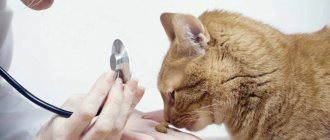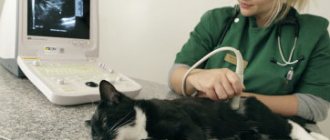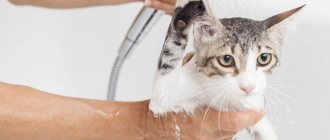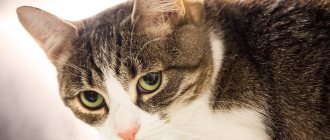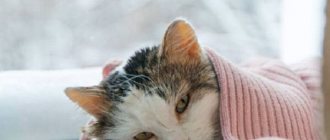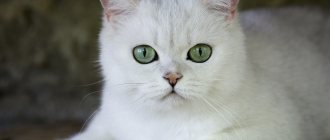Why kidneys are a weak point in cats
Scientists explain this for two reasons:
- Natural predisposition. Domestic cats have an ancestor - the African desert cat. She went without water for a long time, a feature she passed on to her descendants. They drink little and not regularly. The water balance is disrupted, which affects the functioning of the kidneys.
- Anatomical features. The cat's urethra is long, thin, and has three constrictions. In these places, urine is retained and not drained. This is a load on the kidneys.
Sick cat
Ktxtybt
In severe cases (especially with chronic renal failure), the animal’s condition will quickly deteriorate, despite the attempts of veterinarians to stop the pathological process. Perhaps the only way to prolong a pet’s life is regular hemodialysis, but in our conditions this is unrealistic.
Regular blood transfusions are more realistic, but only very wealthy owners can afford this, and even then not in all cases (we simply do not have blood banks for pets). So the only option left is regular intravenous infusions to help the animal’s body cope with intoxication.
Over time, owners of “heavy” cats may have hope: several studies are currently underway in the field of veterinary transplantology.
But still, one should not particularly count on the “miracles” of medicine. Practice shows that only those animals that are treated in the early stages have a certain chance of recovery.
What does the treatment of kidney pathologies in cats mean?
Electrolytes, vitamins and fatty acids are the basis for maintaining the quality of life of a sick cat at the proper level. It is believed that in case of many kidney diseases, the amount of phosphorus entering the body with food should be reduced, while maintaining or increasing the proportions of calcium (a lot of it is lost in the urine, which is fraught with bone problems).
The same applies to vitamin D - under normal conditions, the cat’s body perfectly synthesizes it itself, but in case of kidney pathologies, all reserves of this compound are safely washed away by urine.
Interestingly, for some diseases, it is useful to add a small amount of ordinary table salt to cats’ food, but there is no need to get carried away: firstly, NaCl poisoning has not yet been abolished. Secondly, salt increases blood pressure, and in the case of acute nephritis, for example, it can already go off scale. It is also recommended to monitor potassium levels: if there is a lack of it, there will be interruptions in the heart’s function, and if there is an excess, there will be convulsions.
Causes of abnormalities in kidney function in cats
The main thing is age. After 7 years of life, all individuals suffer from kidney problems.
Polycystic kidney disease in cats: symptoms and treatment
Causes:
- improper nutrition - there is either no protein in the diet at all, or an excess;
- drinking water in the region is hard, saturated with salts;
- the cat was castrated early;
- genetic predisposition;
- infections, poisoning;
- injuries;
- congenital anomaly.
Important! All individuals over 7 years of age are at risk for kidney diseases. They are shown to the veterinarian annually, undergo tests, and undergo clinical kidney examinations.
What symptoms require you to contact a veterinarian, what is the prognosis?
The owner must carefully monitor the cat's condition so as not to miss the first signs of incipient kidney disease. The risk group includes animals over 6 years old. In older felines, the kidneys fail more often than any other internal organ.
The owner should pay attention to how often the animal goes to the toilet: constantly dry litter in the tray is a cause for concern. Painful urination (the cat meows pitifully, repeatedly sits down on the tray, “rolls” on its butt) and, especially, urine with drops of blood require immediate consultation with a veterinarian.
Thus, chronic nephritis in cats has a positive prognosis if the symptoms of the disease are noticed in time and treatment is started. Swelling of the eyelids and ears, yellowness of the mucous membranes, whitening of the gums and the unpleasant smell of ammonia from the mouth indicate severe intoxication of the body. The responsible organs do not perform the filtering function and all toxins enter the blood, and the process of poisoning occurs. What to do?
A sick animal must be immediately taken to the clinic and, in addition to diagnostic procedures to identify the disease, urgent detoxification therapy must be carried out. Perhaps the animal can still be saved.
The kidneys in a cat’s body maintain acid levels, regulate blood pressure, and generate hormones. Veterinarians know that kidney disease in cats is more common than other diseases.
Factors influencing the development of kidney diseases
Cat diseases: symptoms, table, treatment
The owners look after the health of the cats. But there are factors that predispose to the development of kidney disease:
- the cat is too fat or very thin;
- drinks little;
- the food is too salty or contains too much sugar;
- eats a lot of meat and fish;
- sleeps in a draft, lives in a damp room;
- cannot go to the toilet on time;
- source of infection in the body itself (caries);
- sedentary lifestyle.
What signs indicate kidney problems?
Feeding fish and dairy products containing a lot of mineral salts leads to the deposition of salt crystals on the walls of the animal's kidneys. In nature, representatives of the cat family rarely eat such food, so their body is not equipped to properly digest it.
In addition to poor nutrition, there are other provoking factors:
- excess salts in dry food;
- lack of water in the body (violation of the drinking regime);
- overweight animal;
- sedentary lifestyle;
- forced urinary retention (the pet is unable to go to the toilet on time due to a dirty tray or a closed door);
- living in a damp room and in drafts.
The following signs indicate kidney problems in cats:
- poor appetite and weight loss;
- decreased activity and long sleep;
- constant thirst;
- frequent and painful urination;
- blood in the urine;
- smell of ammonia from the mouth;
- dental diseases and whitening of gums.
In the early stages of the disease, such symptoms appear periodically, so they often go unnoticed for a long time. The final diagnosis is made only on the basis of laboratory tests, therefore, if the animal is suspected of feeling unwell, it should be immediately taken to the veterinarian.
Common kidney pathologies
Cats are clean animals. If they stop brushing their fur or behave apathetically, the owners go to the veterinarian. They are looking for the cause in the urinary system.
Hepatopathy in cats: liver diseases, symptoms and treatment
Not everyone knows where a cat’s kidneys are, but the cause of the disease often lies in them. The most common diseases of this organ are caused by bacteria and associated inflammation. These are all types of cystitis and nephritis.
Causes of kidney failure and its types
The kidneys constantly filter the blood from toxic substances, so their pathologies develop.
The most common problem is kidney failure. There are two types:
- Chronic. They are provoked by poor care: hypothermia, or the cat is kept in a room that is too hot. Metabolic disorders and diabetes mellitus also lead to misfortune. The organ is destroyed, the disease is not completely cured.
- Spicy. Spontaneous inflammation with rapid development. More dangerous than chronic - the organ may fail. Causes: stress, heart disease, blood pressure, ICD.
Nephrosclerosis
There is protein and blood in the urine. Frequent urination, urine volume decreased. A biochemical blood test and kidney ultrasound are performed. It is determined: the connective tissue has grown, the organ is poorly supplied with blood. In this case, the kidneys shrink and do not perform their functions.
Treatment: diuretics, laxatives, heart medications, antibiotics.
Provide proper nutrition: 4-5 times a day, reduce salt and proteins.
Hydronephrosis
Hydrocele of the kidneys occurs when the urinary tract becomes narrowed. The kidneys become full and stretched. Subsequently, functional tissues die.
Causes: trauma, inflammation. New growths may appear in the abdominal cavity and compress the bladder.
An ultrasound examination is performed.
Important! This disease can only be cured by surgery.
Pyelonephritis
The animal is hunched over on the tray, there are bloody and purulent spots in the urine - the cat’s kidneys hurt, the symptoms are the same.
Bacteria infect the upper urinary tract, and purulent inflammation develops in the pelvis.
Chronic nephritis and diabetes mellitus lead to pyelonephritis.
Other factors:
- hypothermia;
- renal failure;
- difficult childbirth;
- poisoning
When an organ begins to fail, antibiotics and antimicrobial drugs are prescribed.
Amyloidosis of the liver and kidneys
Rare disease. Protein metabolism disorder. The protein settles on the internal organs, they stop functioning.
Anything that reduces immunity causes amyloidosis of the liver and kidneys. The protein is deposited in the kidneys, causing chronic renal failure.
Signs:
- weight loss;
- swelling of the paws and muzzle;
- thirst;
- dark urine;
- dyspnea.
Important! Amyloidosis of the liver and kidneys is an incurable disease.
Polycystic
Hereditary disease. Characterized by the formation of cysts with fluid. Location: outside the kidneys and on the upper urinary tract.
Examination by a veterinarian
Symptoms:
- the cat does not allow you to palpate the kidney area;
- drinks a lot, eats little;
- loses weight, gets tired;
- mucous membranes turn pale;
- frequent urination with blood;
- mouth ulcers;
- blood pressure increases;
- the fur is dull, vision is reduced.
The animal is given a blood transfusion, symptomatic treatment is given, and blood pressure is maintained.
Nephritis
Inflammation of the kidneys of an infectious or allergic nature. Nephritis occurs after a viral attack, poisoning, or after worms. The disease is also caused by hypothermia and urolithiasis.
Nephritis is indicated by:
- frequent trips to the litter box, resulting in less urine;
- diarrhea, apathy;
- jaundice;
- swelling of the eyelids and paws.
Cats are fed in moderation. Cut back on salt. They give foods containing potassium, calcium and carbohydrates.
For reference: if the owner reacts in time, the disease is easily treatable, and the cat remains healthy for many years.
Glomerulonephritis
The reasons have not been identified. There is blood and protein in the urine. More likely, an allergic reaction to low-quality food. The paws and submandibular space swell.
Provoke the disease:
- swimming in cold water;
- keeping in a damp room;
- great physical activity.
The kitty is put on a salt-free diet, bloodletting is done, and glucose is injected subcutaneously.
Why are kidneys needed?
The kidneys are a paired organ (there are two of them in the body), which performs many different functions: hormonal, maintaining the acid level and electrolyte composition of the blood, regulating blood pressure. But the main task of the kidneys is to filter metabolic products. The kidneys constantly cleanse the body of toxins and maintain the required amount of water in the body. Detoxification is carried out by the formation and excretion of urine with harmful substances dissolved in it.
The bud has the shape of a bean. On the outside it is covered with a dense capsule; inside there is a layer of kidney tissue itself. Without going into anatomical details, the kidney can be conditionally divided into two functional parts: the renal tissue itself is responsible for filtering the blood with the formation of urine, and the pyelocaliceal system is responsible for the accumulation and excretion of this formed urine.
The kidneys are made up of small structural units called nephrons.
It is in them that the process of urine formation occurs. Of course, one nephron filters the blood and produces urine in very small quantities, but if you consider that there are about 200,000 of them in each kidney, the result is liters. Now the most important thing: the kidneys are not capable of regeneration! The number of nephrons in the body is determined from birth; new ones do not “grow.” And if the nephron is lost, then it is irrevocable.
Treatment of kidney diseases
When symptoms indicate kidney disease in cats, treatment is prescribed.
Treatment of a cat in the clinic
The following activities are carried out:
- eliminate the underlying and concomitant diseases;
- use medications (subcutaneously, intravenously);
- give a course of antibiotics when there are infections;
- use fluid therapy when dehydration is observed;
- use physiotherapeutic methods;
- follow nutritional rules;
- They are treated with traditional methods, herbal infusions (mint, lemon balm, St. John's wort, oregano).
Symptoms of the disease
Symptoms of pyelonephritis in cats depend on the stage of the disease, the severity of associated factors and the general immune defense of the cat's body.
The nature of the manifestations also depends on the form of the disease - acute or chronic. In acute forms of pyelonephritis, the symptoms are pronounced, the animal suffers greatly, and severe pain develops in the lumbar region (the location of the kidneys). The chronic form of the pathology has a blurred clinical picture.
The acute form of the inflammatory process in the renal pelvis is characterized by the following symptoms:
- prolonged feverish conditions (the animal gets chills);
- increased cat fatigue, apathy and indifference to various kinds of stimuli;
- severe pain in the kidneys (renal colic, provoked by spasms of the smooth muscles of the ureters and pelvis of the organ);
- painful sensations in the abdominal area during palpation (renal pain can be so severe that it radiates to the hind limbs, lower back and abdomen);
- disturbances in the act of urination (the amount of urine excreted is reduced, and the urine itself acquires a rich straw color, sometimes with admixtures of blood and pus, and a concentrated, repulsive odor appears);
- disturbance of the rhythm of breathing and heart contractions.
It is important to immediately show it to a specialist when one of the above signs appears in a cat. This will allow you to immediately prescribe a series of laboratory tests of urine and blood, making it possible to give an accurate assessment of kidney function
The purulent form of pyelonephritis and renal failure can cause uremia. This is a particularly acute syndrome of autointoxication of the body with nitrogenous metabolites and other toxic substances obtained during the breakdown of proteins. Substances such as ammonia, cyanate, guanidines, urea, acetone and phenols accumulate in the body.
Clinical signs of uremia, developing against the background of an advanced stage of pyelonephritis, are characterized by refusal to feed, apathy and polydipsia (increased thirst). The cat’s body temperature drops, not rising above 37 degrees. Retardation of movements and convulsions develop against the background of poisoning of the nervous system with toxic substances.
In the absence of help, the cat may experience an eruption of gastric contents and stool upset. The smell of ammonia comes from the mouth. General intoxication of the body leads to disturbances in the functioning of liver structures and blood factors.
Anemia and thrombocytopenia develop. Extensive internal hemorrhages may occur. Uremic coma occurs and, as a consequence, death.
Medicinal feed as a method of prevention
During the period of treatment of pets for kidney diseases, the rules of nutrition are followed. Feed little by little 4 times a day. There must be water constantly.
The diet is balanced, low in salt. Monitor the protein content in food.
Dry and canned food is of high quality. Preference is given to specially developed medicinal ones.
They prepare natural products: boiled chicken, rabbit meat, vegetables, porridge.
Attention! You cannot constantly feed your cat dry store-bought food.
She begins to become dehydrated and have kidney problems.
Preventive measures
When getting a cat, a person should think about how to minimize the possibility of long-term exposure to factors that predispose to the development of irreversible kidney damage. It is necessary to provide the animal with high-quality care and appropriate conditions in order to prevent severe pathologies and diseases of important organs.
Prevention measures that slow down kidney disease:
- sufficient clean water for drinking;
- regular examinations by a veterinarian;
- a balanced diet that does not include salty or sweet foods;
- minimum proteins in food and maximum vitamins;
- no risk of hypothermia or poisoning;
- timely treatment of infectious, colds and other diseases, and most importantly, kidney diseases;
- favorable living conditions;
- regular walks in the fresh air, increased physical activity;
- compliance with hygiene rules;
- compulsory vaccination;
- identifying predisposition to certain diseases and conducting timely examinations;
- compliance with the veterinarian’s recommendations regarding the prescription and dosage of medications during the treatment of any disease.
Questions regarding kidney problems and their treatment should be discussed with your veterinarian. Self-medication or the use of questionable drugs and drugs is not allowed in this case.
Main symptoms of pyelonephritis
Since the disease is quite insidious, it is important to recognize it in the initial stages and begin treatment. To do this, you need to know the main symptoms of pyelonephritis in animals.
And so, the following symptoms indicate the disease:
- fever;
- the cat becomes lethargic and apathetic;
- constant thirst (the animal drinks a lot of water);
- vomiting, diarrhea;
- refusal of food;
- frequent and numerous urinations;
- pain when urinating, the cat makes meowing;
- changes in the color and odor of urine;
- increased heart rate, breathing;
- When palpated in the back area, the animals experience severe pain, so they escape from the hands.
All of the above symptoms most often appear in combination, so noticing them will not be difficult. But you should never self-medicate. The cat must be immediately shown to a veterinarian who will make the correct diagnosis. You need to understand that pyelonephritis is a serious disease that can affect the kidneys, ureters, and urethra. During this period, stones may occur, which will aggravate the animal’s condition. Therefore, before treating sick animals, they need to be examined.
